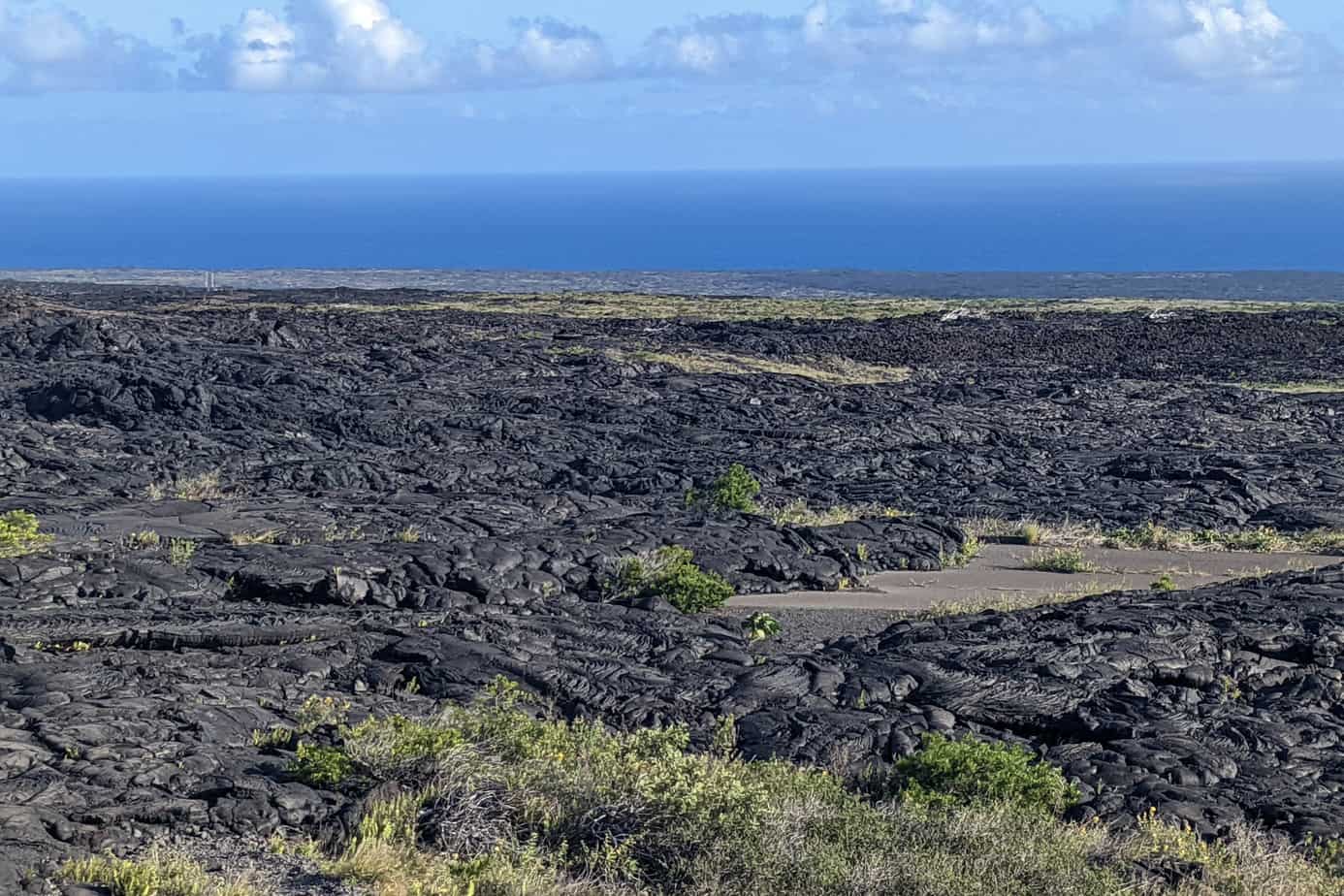Volcanoes National Park Itinerary for 2024
Volcanoes National Park is one of the must-see places on your trip to The Big Island. The volcanic landscape and the chance of seeing lava make it unlike anywhere else. But, there are some tricks to making sure you have the best day possible when you visit.
My mom used to live on the island near the national park so I got insider tips when I visited. This post passes on those tips and my experience so you can plan the best Volcanoes National Park itinerary for you!
Read on for information about the park, getting there, what to see, hikes to consider, and where to sleep. This post has everything you need to know to plan your trip!
Some of the links on the page are affiliate links. If you choose to purchase from one of the links, I earn money at no extra cost to you. I’ll only recommend brands I’ve used and love (or an alternative I would book myself). As an Amazon Associate, I earn from qualifying purchases. I always pay for my own travel. I’ll be sure to let you know if that ever changes. If you choose to click through and purchase – thanks so much for the support!
About Volcanoes National Park
Hawaii’s Volcanoes National Park is a true gem; there is nothing else like it in the US. The park is home to two of the most active volcanoes in the world; Kīlauea and Mauna Loa.
The place is also a sacred one for Hawaiians. One of my favorite parts of visiting the park is seeing how much effort goes into preserving the culture and heritage around the sacred space. Even the park website gives a great deal of information about the cultural and religious meaning of the park.

Where is Volcanoes National Park?
Volcanoes National Park is on the north side of The Big Island near Hilo. The northwest side of the island is the side where you’ll find the best waterfalls and lush vegetation.
If you’re staying in Kona or Waikoloa village it will take 2 hours to get to the national park. Hilo is much closer at a 45-minute drive.
Entrance Fees and Other Things to Know
The park is open daily and all day. The visitor center is open from 9:00 am until 7:00 pm. Even if you don’t usually stop at visitor centers this is one you should see. Talking to the rangers in the park clues you in on what’s happening with the volcano. Since the volcano isn’t predictable getting their input on where it is the day you’re visiting is important.
All visitors need an entrance pass to come into the park. They are $30 for one vehicle for up to 7 days. You can buy them online before you visit. Note that cell services aren’t great in the park so download your pass before you get there. You can purchase the pass from the entrance gate too.
As of May 2023, the park is cashless.
If you’re visiting more than one national park in the year, like Haleakala on Maui, consider purchasing the annual pass for $80. You can’t purchase this pass online. You’d have to get it when you visit a park but it’s a great deal!
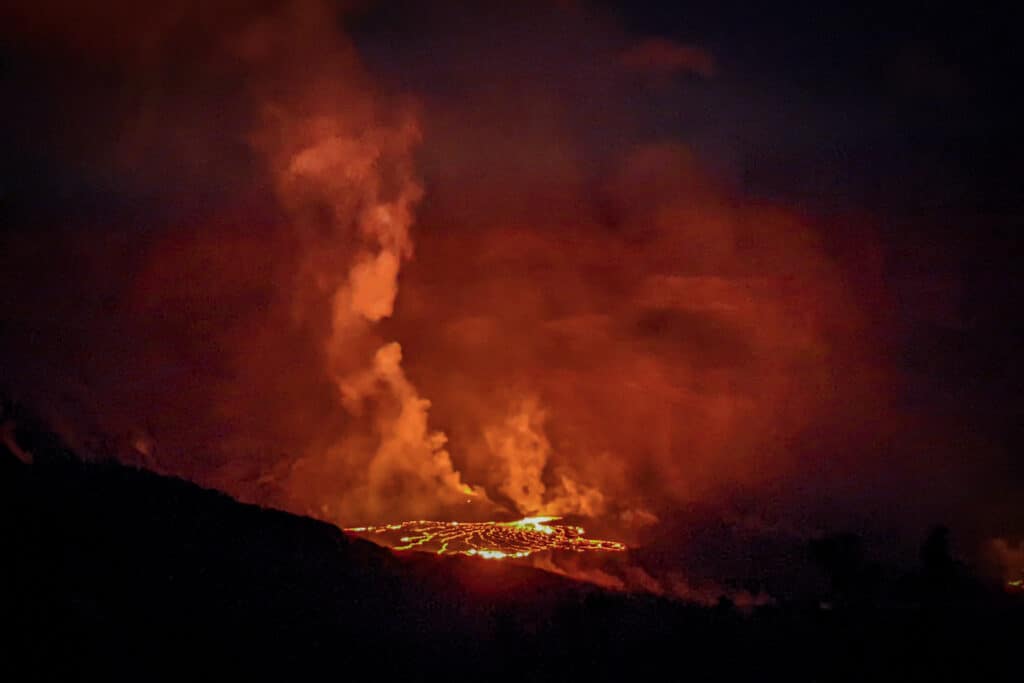
Lava Viewing at Volcanoes National Park
There is a chance that you’ll be able to see lava on your trip to the park; it’s the highlight of a Volcanoes National Park itinerary.
If this is something that excites you, stay on the Hilo side of the island for a night or two. This gives you the best shot!
You’ll only be able to see the lava at night. The skies have to be dark or it just looks like steam and smoke.
The park webcams can give you some idea about what’s happening before your visit. But, conditions change day to day so check with rangers at the visitor center to get their advice and make your plan from there.
Tours to Look Into If You Don’t Want to DIY
- Volcano Exploration from Hilo– Volcanoes National Park and then some
- Volcanoes National Park from Kona or Waikoloa
- Volcanoes National Park by Helicopter!
- The self-drive option
Volcanoes National Park Itinerary-
Staying in Hilo
Staying on the Hilo side of the island means you’ll get more time to visit the park. You can work it out to have a few days there or just a couple of nights. Staying in Hilo gives you the most flexibility in your Volcanoes National Pak itinerary.
This itinerary assumes you’ll be spending 2 nights in Hilo but will have one full day in the park.
To spend more time add on some hikes that you’re excited about or read on below for other things to do in Hilo.
Morning
Get an early start to your day! Waking up in Hilo means you’re only 45 minutes from the park but you want to spend as much time as possible there before the crowds show up.
Aim to arrive at the Nāhuku (Thurston Lava Tube) at least a few minutes before 8:00 a.m. This is when the tube will be lit but before traffic peaks. Bring headlamps to start earlier if you feel like you can wake up for it.
After your hike in the lava tube, head to the end of Crater Rim Road. Take in the overlook at Uēkahuna and make your way back. Take your time to see the steam vents and hike the Ha‘akulamanu (Sulphur Banks) boardwalk.
Afternoon
After exploring Crater Rim Road stop at a picnic area for lunch. There are no restaurants in the park so you’ll need to pack in your lunch and snacks.
There are picnic tables at the visitor center. I’d recommend eating here so you have a chance to see the visitor center and maybe talk to some of the rangers to get lava flow information.
But, you can eat in your vehicle or head down Chain of Craters road to the Kealakomo picnic area.
After lunch continue down Chain of Craters road to the end. Walk out to the sea arch and be sure to spend time admiring the massive lava fields.
Note that this part of the day will likely be quite warm. Bring lots of water and sunscreen.
If you have time and energy hike the Puʻuloa Petroglyphs trail.
Evening/Night
When you finish up your afternoon on Chain of Craters road head out of the park back to Hilo. This may seem unconventional and you are welcome to change the itinerary and stay in the park if you’d like.
But, staying in Hilo allows you to leave the park and eat dinner.
Then, come back to the park around 10 pm to see the lava flow (if there is one). The crowds of people who don’t know they should’ve stayed in Hilo have to leave to make their way back.
So, as they’re all exiting you can come into the park and should have less trouble finding parking.
Where to Sleep
There are several small local hotels in Hilo.
The SCP Hotel was where I stayed and I loved it. The hotel has a mission of service in the area and they have kombucha on tap which is right up my lane! If this place has availability in Hilo you should check it out!
I usually give more than one option but I want you to stay here so I won’t this time.

Where to eat in Hilo?
Hilo is much smaller than the Kailua-Kona side of the island and much more residential. But, there are still some great places to eat.
The Booch Bar
110 Keawe St
8 am – 8 pm Daily
The Booch Bar is a fun little place in Hilo. They brew their kombucha and have some amazing flavors. There is also a cafe and restaurant that serves amazing food. They were great with gluten-free and dairy-free items.
The smoothie bowls are delicious. The bibimbap and the french toast were delicious as well!
Hilo Bay Cafe
123 Lihiwai St.
Wednesday- Saturday | Lunch: 11:00 am- 2:00 pm | Dinner: 5:00 pm – 8:30 pm
Reservations Recommended
Hilo Bay Cafe is hands down the best view of any restaurant in Hilo. I met a local there; a friend of my mom’s. She claims this restaurant is the best one to bring visitors to. It was fun eating at a place my mom knew about from her time living on the island!
The sushi was delicious but the cast iron cookie was gluten-free and a must.
Naung Mai Thai Kitchen
86 Kilauea Ave
Open everyday 11 am-8:30 pm
Naung Mai is a small restaurant in the city of Hilo and it may have been home to the best Thai food on the island. The place is small so expect a wait or go early. But, most of the menu is gluten-free so I had a great time trying new things! The menu is mostly in photos (no descriptions). If that stresses you out give it a look before you go or just ask for recommendations.
My Favorite Things I Took to Hawaii
- Be sure to use reef-safe sunscreen. This is my favorite.
- This waterproof camera is a perfect alternative to a go-pro when you’re snorkeling or diving.
- My Nikon Z5 is my go-to camera for all of my travels. It’s lightweight and water-sealed!
- If you get motion sick bring all of the things you need for water-based activities; motion sickness bands are a favorite of mine.
- My Fjallraven bag is my go-to day bag when I’m not hiking.
- This bag keeps your phone from getting wet when you’re near the water.
Volcanoes National Park Itinerary-
Staying in Waikoloa Village/Kailua-Kona
Staying in Waikoloa Village or Kailua-Kona means you’ll have about a 2-hour drive to get to the park. Your itinerary for Volcanoes National Park will be shorter since you’ll have 4 hours of driving.
Leave as early as you can but try to be at the park by 9 am at the latest. Note that this means you’ll be coming in with lots of others from the same area.
It’s worth it and it’ll be fine but it’s worth noting beforehand so you aren’t surprised.
Morning
Start your day at the visitor center. Learn about the park and talk to a park ranger about the lava flow and current conditions.
Then, drive to the end of Crater Rim Road. Start at the overlook at Uēkahuna. The steam vents and the Ha‘akulamanu (Sulphur Banks) boardwalk are worth checking out. Spend time looking out at the crater and reading the placards to learn more about the volcanic activity here and the more recent eruption in 2018.
Plan to drive past the lava tube parking lot since parking will likely be full. But, if you’d like to take a turn and see if you get lucky you can. I wish you luck!
Afternoon
Drive out the Chain of Craters Road to the Kealakomo picnic area. Make any stops along the way that you’d like. The craters and pull-offs are great ways to break up a long drive.
On a day trip, I recommend driving to the end of Chain of Craters road and then making your way back. It makes it easier to gauge how much time and energy you have left! But, note that on this drive you may need to stop on the way out to access some of the pull-offs.
The area at the end of the road has some incredible views of the hardened lava flow and the Pacific Ocean coming together.
Evening
If the lava is flowing you’ll have to stay until dark to be able to see it well. It’s worth planning your day around the lava flow. It was by far one of the best experiences in the park.
Pack extra food and snacks with you so you can have dinner in the park. If you’d like to leave the park for an early dinner in Hilo that’s an option too.
Remember that you have a 2-hour drive back to your hotel. So, if you’re too tired you may have to head back before the lava flow is visible.
Maybe you can nap in the car?
Where to Sleep
The Hilton Waikoloa Village was the Kailua-Kona resort I stayed at. It is a massive property but it was a lovely stay. Plus, there’s some good snorkeling on site!
Other things to see on the Hilo Side of the Island
Since Hilo gets more rain than the Kona side of the island it also has more vegetation and waterfalls! The best jungle views that Hawaii is known for are on this side of the island!
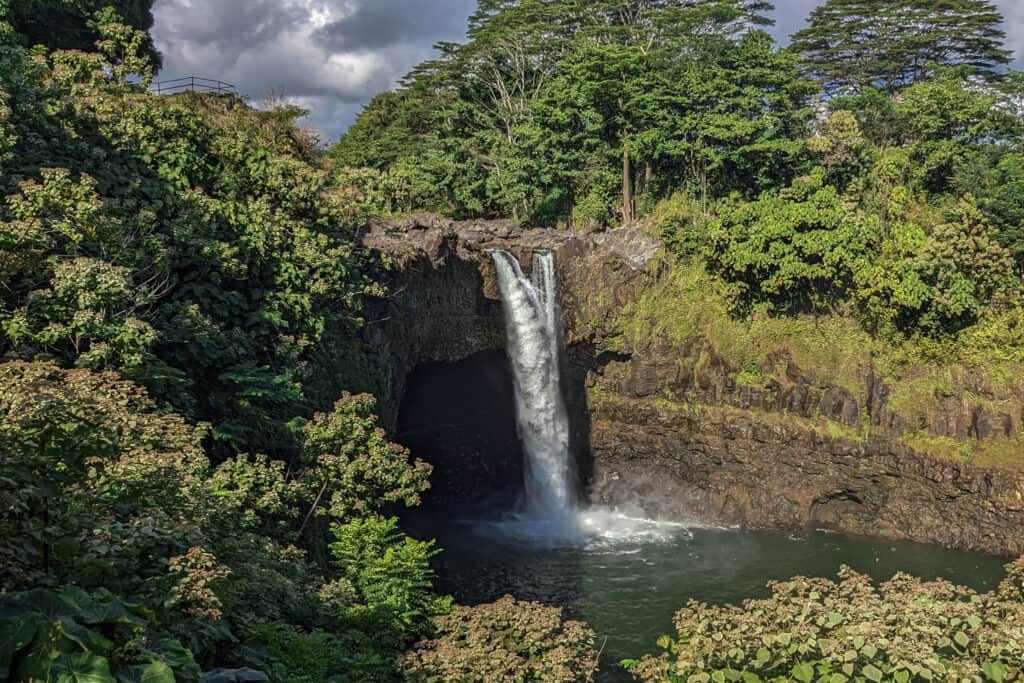
Rainbow Falls
2-198 Rainbow Dr
No admission fee
This waterfall is located in the Wailuku River State Park. It’s a quick paved walk; think under 1 minute.
This 80-ft waterfall cascades in front of a lava cave. It’s said to be home to the Hawaiian mood goddess, Hina.
The waterfall gets its name from the vibrant rainbows that can appear. To see the rainbows visit in the morning since that’s when the sun is in the right place to create them.
Since this waterfall is so beautiful and so easily accessible there are often crowds here. There is a large parking lot though.
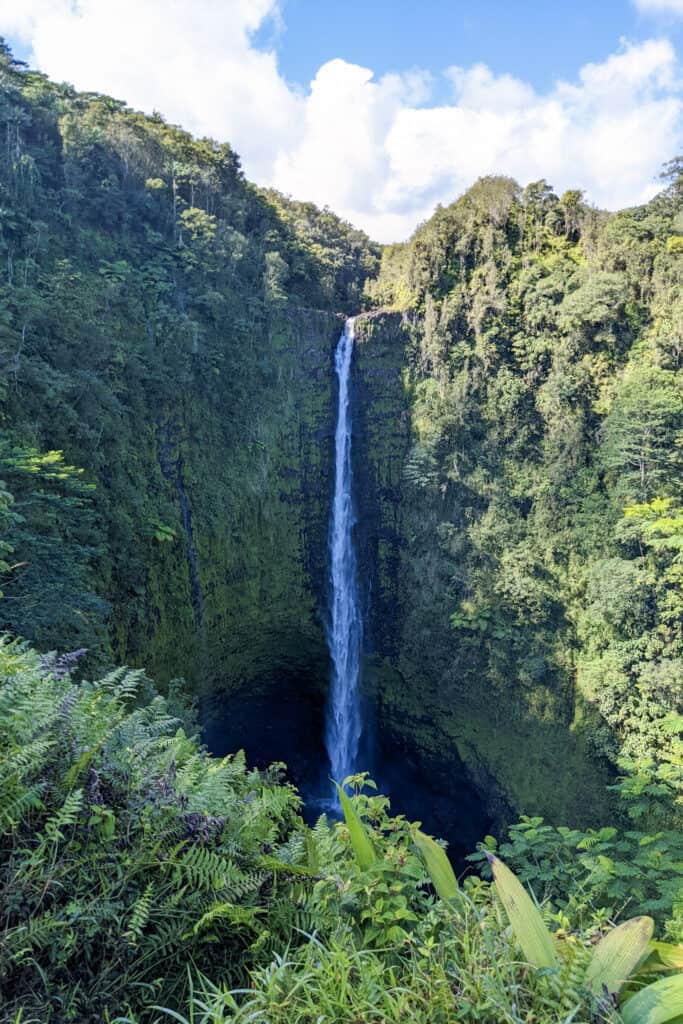
Akaka Falls
Navigate to Akaka Falls State Park- It’s at the end of Akaka Falls Road
$10 Parking Fee/car + $5 admission/person
Credit Card Only
Akaka Falls is massive and stunningly beautiful! It may be the best waterfall on The Big Island. This hike (walk?) to a 400 ft waterfall is a must on the Hilo side of the island. If you have any time at all you should check it out.
The trail is a loop trail that is .4 miles long. Even though it’s relatively easy to hike there are stairs so it isn’t wheelchair accessible.
The stairs can be a bit steep but the crowd is often quite dense so you’re taking them slowly anyway.
Liliʻuokalani Gardens & Hilo Bay
Located near Hilo Bay Cafe you’ll find a beautiful garden to walk through. If you’re looking for Instagram-worthy photos there are lots of options here. This 24-acre park is massive. The Japanese garden is relaxing to sit in and wander around.
What to See and Do in Volcanoes- The Details
There is so much to do in the national park! It will keep you busy even if you aren’t someone who loves to hike. But, if you’re a hiker there are lots of options for you too!
Kīlauea Visitor Center
The visitor centers in the national parks are always a good stop but the one here is better than some. The landscape and volcanic activity here is unlike anything most Americans have experienced. So, spend some time learning about the islands and the volcanoes. Plus, check with the rangers about the current lava flow and activity of the volcano.
If you’re interested in day hikes be sure to get a hiking map at the visitor center and talk to them about which hikes to consider.
Crater Rim Road
There are two main roads in the park and Crater Rim Road is one of them. This road gives you excellent views of the Kīlauea caldera and Halemaʻumaʻu crater. Start your drive by going all the way out to the end of the road. Then, you can easily work your way back.
Uēkahuna
This is the highest point on the rim of the crater. It’s a special place for Hawaiians and provides visitors with the best view of the large crater. It’s a little bit of a drive out to the lookout point but it’s worth it.
Kīlauea Overlook
This overlook gives you the best view of the results of the lava flow of 2018. The Halemaʻumaʻu crater collapsed during this lava flow and changed the scenery dramatically. Walk along some of the Crater Rim Trail. Be on the lookout for placards that show what the area looked like before and after the lava flow.
It’s dramatic and very interesting.
This overlook has restrooms available.
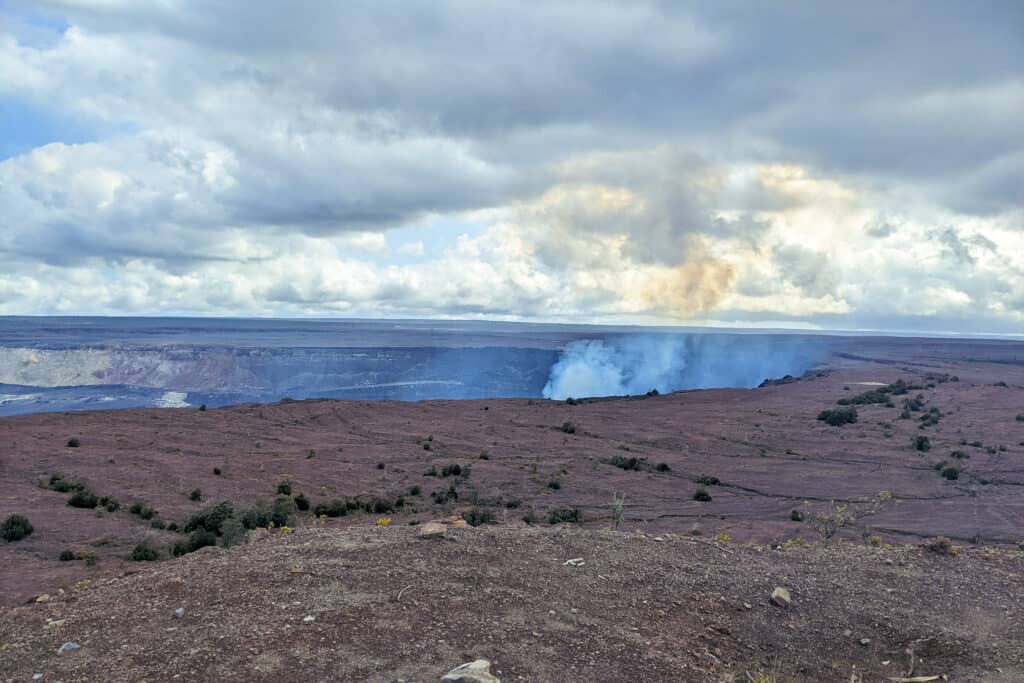
Wahinekapu (Steaming Bluff)
This is one of the more unique experiences in an already unique park. The rocks below the ground are heated by the magma. When water drips onto them it comes out of the massive vents as steam. Walk around and experience the difference between the cooler air at the top of the mountain and the hot steam coming out of the vents.
Just be careful; the steam was much warmer than I gave it credit for. It was fine but it was shocking!
Nāhuku- Thurston Lava Tube
Nāhuku is a popular hike in the park.
The 1.5-mile hike starts at the Kīlauea Iki Overlook pullout. Parking is very limited. If parking is full you’ll have to keep driving and come back another time.
Since the hike is so popular it’s best to start before 9 am or after 4 pm. This helps you avoid the crowds (and have a better chance at a parking spot).
The tube is lit from 8 am until 8 pm. If you choose to hike outside of these hours bring headlamps or other ways to light your path.
But, the hike is popular for a reason; hiking through a lava tube is one of the most interesting things you can do in the park!
The only other place I’ve seen something like this is in the Pacific Northwest near Mt. St Helens.
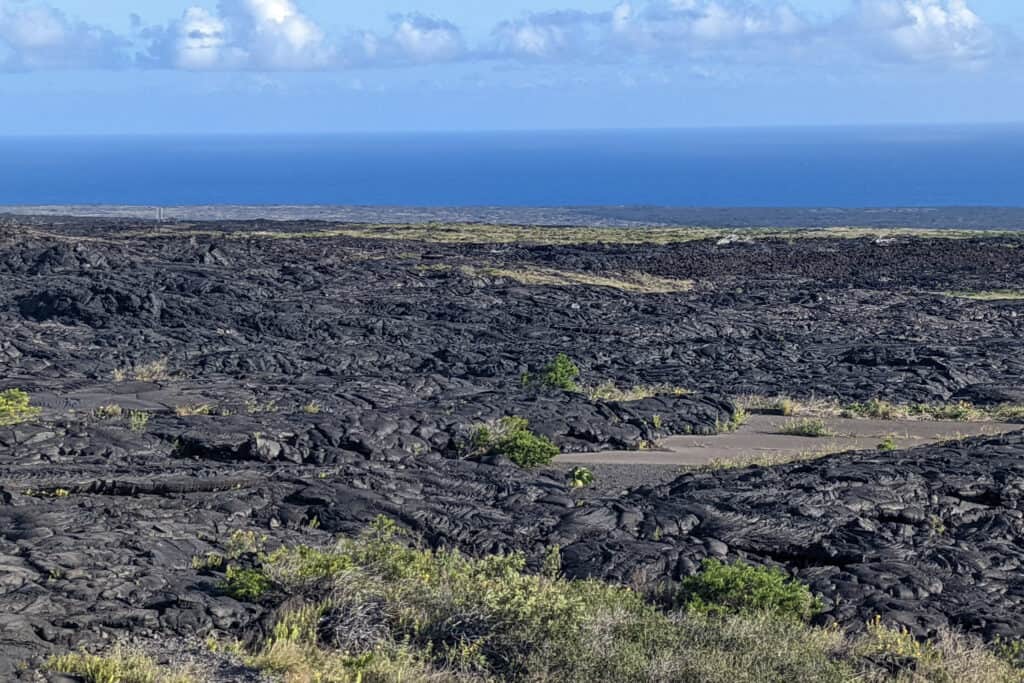
Chain of Craters Road
The other road in the Park is Chain of Craters Road. The road is 18.8 miles long but there is no food, water, or gas. Be prepared before you head out on this road.
There are several stops to make on the way but the highlights are below
The scenery is dramatic. It’s an incredible drive!
Puhimau Crater
This is one of the first stops on the road and the deep crater is not unlike the others you’ll see along the road. There are still some steam vents so you may get lucky enough to see some steam coming out.

Pauahi Crater
This crater is a massive 360 ft deep and 1,600 feet long. It’s also been the site of volcanic activity in recent history.
Stopping off at the crater doesn’t take long seeing the massive crater is worth the stop.

Mau Loa o Maunaulu
This is the site of a lava flow from 1969 and 1974.
The landscape here is special. This area makes you feel like you are on another planet.

Kealakomo Overlook
This overlook allows you to see the lava flow and the Pacific Ocean. The contrast between the black hardened lava and the bright blue ocean is striking.
Get out at the overlook to admire the sea of shiny, black-hardened lava. It looks like a river was frozen in time. It’s also a great spot for photos!
Hōlei Sea Arch
At the end of Chain of Craters road stop and find a parking spot.
The road used to continue but the lava flow in 2018 went over it. So, now, the road is much shorter. When you get out of the car you can walk down the road for a view of the Hōlei Sea Arch.
The sea arch is stunning but the hike out is hot. There is no shade and the sun can be unrelenting. Be sure to have water and sunscreen.
Also, as you walk around the viewpoint be aware that the lava rock is slick and sharp. Take care walking around to avoid any injuries.
My Essentials for National Park Trips
Great Hiking Shoes. I love Chacos sandals AND my Timberland boots. I really hate hiking boots so it’s high praise for these Timberlands! Chacos pro tip- don’t be tempted by the 3-string option. They are impossible to adjust.
Thick, comfortable socks to keep my boots from rubbing my feet. As a bonus, I can wear them with my Chacos like a total dork for that weird “not quite warm enough” weather.
My Osprey Day Pack. I’ve had it for years. I have no intention of ever getting another day pack.
Binoculars are a must. Every time I forget them I regret it.
My Nikon Z5 is my go-to camera. I love the 70-200mm lens for photographing wildlife.
My Eddie Bauer Rain Foil Jacket is the best rain jacket.
Hikes to Consider on Your Visit
There are several day hikes to choose from in the park.
How many you can do will depend on how long you’re in the park and how much of the heat you can handle.
Don’t overdo it for a hike.

Ha‘akulamanu (Sulphur Banks)
Crater Rim Road
1.2 Miles
Easy
This easy hike is a perfect way to get out of the car if you don’t want a strenuous hike. The hike is easy but the smell is strong.
The gases and steam rising out from the vents in the Earth have the sulfur smell that goes along with the volcanic activity. But, the landscape is unique and the hike is easy. So, if you can handle the smell it’s worth it!
Nāhuku (Thurston Lava Tube)
Crater Rim Road
1.5 miles round trip from Kīlauea Iki Overlook
Moderate
Parking is very limited.
This hike is one of the most unique hikes you can do in the park. If you can only fit in one of them this should be a top contender. But, it’s popular so it gets busy.
Try to go early (before 9 am) or stay later in the day (after 4 pm) to avoid the crowds and snag parking.
The lava tube is lit from 8 am until 8 pm. Outside of this time bring headlamps or flashlights.
Devastation Trail
Crater Rim Drive
1 mile Round Trip
Easy- Wheelchair/Stroller Accessible
This paved trail takes you through an area of the park that is recovering a lava flow. You’ll see the landscape and the vegetation that’s trying to grow back.
Kīlauea Iki
Crater Rime Drive
3.3 miles round trip from Kīlauea Iki Overlook
Moderate to challenging
Parking is very limited.
The Kīlauea Iki hike is a longer day trip hike for the area. You’ll descend 400 ft into a crater and you can hike on the lava lake floor.
Note that there are other trailhead options for this hike but they make it much longer. Start early in the day for the best weather and the best chance at a parking spot.
Puʻuloa Petroglyphs
Chain of Craters Road
1.4 Miles
Moderate
Hiking through the lava fields is warm and leaves you exposed to all of the wind, heat, and rain. Be prepared for all of it on this hike.
But, when you get there you’ll see etchings that tell of the history of the Hawaiian people. The ground is delicate so stay on the boardwalk when there is one. Take care when there isn’t a boardwalk as the hiking can be a bit treacherous with the lava rocks.
Is 1 day enough at Volcanoes National Park?
One day is enough to see the highlights with a well-planned Volcanoes National Park itinerary. You won’t be able to do all of the hikes.
But, to be honest, it would probably be too warm to do that anyway (even in winter).
Staying in Hilo gives you the flexibility to plan your visit around the possible lava flow. But, it’s still possible from Kailua-Kona or Waikoloa Village.
Have fun planning your Volcanoes National Park Itinerary!
Volcanoes National Park is a gem of a national park. Take time to plan your Volcanoes National Park itinerary and then enjoy your time exploring a landscape unlike anything else you’ve seen!
